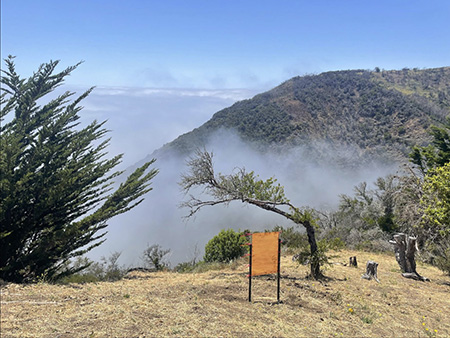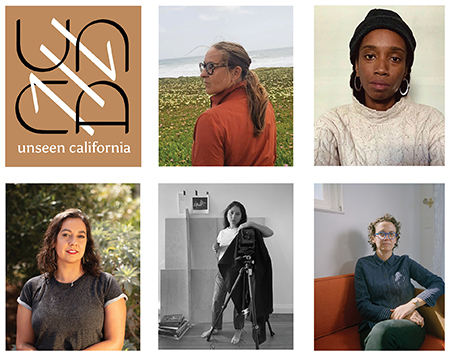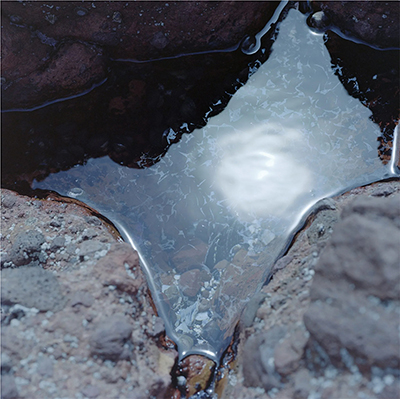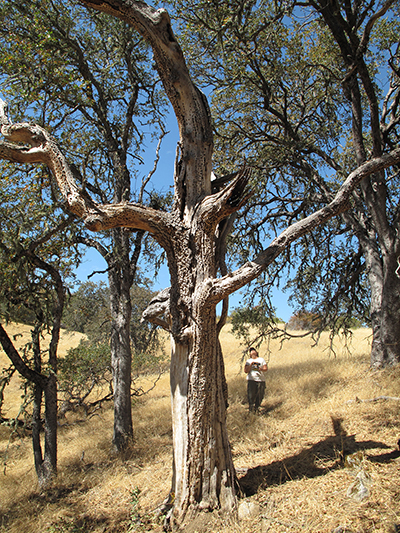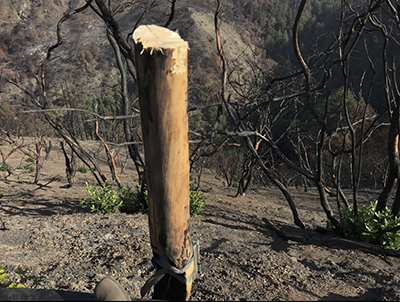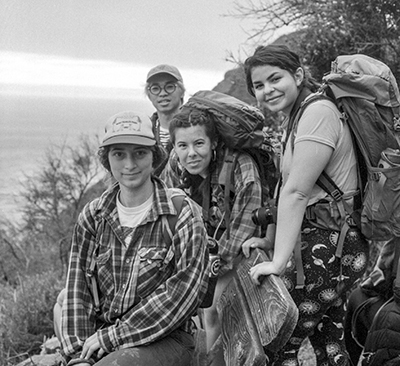The reserves of the UC Natural Reserve System are best known for fostering science teaching and research. But that long-standing reputation is broadening. A new arts initiative from UC Santa Cruz, Unseen California, aims to connect both professional artists and UC students with reserves. Challenging artists to engage with the human and natural history of California landscapes, the program seeks to make the arts an integral part of the NRS profile.
Launched in 2021 by UCSC Associate Professor of Art Karolina Karlic, Unseen California is an arts research initiative that engages diverse artist voices with research themes relevant to California’s future. The program also enables immersive learning experiences for UCSC art students and the community through programming, exhibitions, and an in-progress documentary film.
“The goal is to be able to use the umbrella of Unseen California to support immersive arts field research,” Karlic says. Connecting with reserves, she adds, helps students “realize what it means to create site-specific work and connect with communities at large.” Meanwhile, the participating professional artists get to explore a wide range of ecological locations with assistance from knowledgeable NRS guides.
Reserve visits nudge artists to consider broader questions about their roles as they engage within reserve environments across California, Karlic says. “What is it that we carry with us as humans from engaging with a site? What does it mean to be a practicing artist out in the world?” This dovetails with the principles of the UCSC Art Department, which encourages students to grapple with environmental and community concerns in their art practice.
“The best question that a student has asked me at a natural reserve was, ‘what are we supposed to do here?’” Karlic says. “This question has driven the whole development of Unseen California as a research initiative.”
Launched in 2021 and intended to be a ten-year program, Unseen California has multiple facets. These include immersive art field research by cohorts of professional artists; teaching; and engagement with the public.
A cohort of working artists
The first artist research cohort consists of five women photographers from a wide variety of backgrounds. Each is an educator and a working professional in the arts.
The identities of the artists contrast starkly with the white, cis males (think Ansel Adams, Carleton Watkins, Edward Weston, and others) who have dominated the canon of landscape photography. The Unseen California artists seek to reframe cultural histories and ecological landscapes with alternative concepts enriched by their diverse identities and experiences. They operate under the conviction that the arts are central to solving the most urgent problems of our time, but require participation and engagement by disciplines and sectors across society.
“It was very important for me to create a research cohort that extends outside of the university to engage with our students, with the natural reserves, and that the work expands back into their communities outside of the walls of the university,” Karlic says.
The residencies last for an unusually lengthy two years. This lets artists visit reserves multiple times over different seasons. Artists have the space to reflect on their experiences, and deepen their relationship to place and community with every return.
“The most generous part of this residency is the ongoing conversations and community that I feel is necessary as a woman photographer educator,” says artist Tarrah Krajnak. “Oftentimes the work of an artist is in solitude. Even though we’re all separated and at different institutions working across different reserves I feel actual support for the first time in over a decade.”
A conversation between art and science
Arts research can uncover knowledge about the landscape that is distinct from what can be gleaned by the practice of science, Karlic says. “We’re most typically not going in with a particular question in mind to collect data to find results. What we’re going in with is multiple questions and being informed by the site itself. We’re responding and interpreting those responses that happen.”
The fact that human settlements as well as science questions have been studied at reserves makes the NRS an ideal place to host the initiative. Reserve staff have been helping transmit knowledge about their sites to artists, fostering inspiration and insight in the process. “Experiences with the reserve managers are really integral to being supportive of the curiosities and the research that the artists are engaging with their particular chosen site. Those relationships are propelling and making connections for the artists working across different research themes,” Karlic says.
An example is the work of artist Mercedes Dorame. Dorame herself is Tongva. She has chosen to work at Santa Cruz Island Reserve and Catalina Island in part because her ancestors inhabited what is now the Los Angeles Basin as well as the southern Channel Islands. Her study includes contrasting the feeling of safety and shelter on virtually uninhabited Santa Cruz Island with her experiences growing up and currently living in Los Angeles. During her explorations of the islands, she also has been creating a series of observations highlighting both the past and future potentials of these landscapes.
Jay Reti, director of the NRS’s Santa Cruz Island Reserve, has helped provide Dorame with a deeper sense of cultural connection to the island, says Karlic. “Jay is a paleoanthropologist. He’s very familiar with stone tools in his own research. That knowledge and understanding has been incredibly helpful for Mercedes, who is looking at the exchanges between the peoples of Santa Cruz Island and Catalina Island.”
From acorn caches to fog residue
At Hastings Natural History Reservation, artist Aspen Mays is working with reserve director Jen Hunter to reimagine the reserve’s museum. At present, the building is being used for storage; most of the plant and animal specimens as well as scientific notebooks were relocated to UC Berkeley. Mays will consider how the photographic, field notes, recordings, and other observations from Hastings can be made engaging for museum visitors.
In addition, Mays is investigating the lives of acorn woodpeckers, whose behaviors and interactions with oak trees have been studied at the reserve for more than 50 years. Mays is collaborating with former NRS Environmental IT Director Becca Fenwick, now with the CITRIS Initiative for Drone Education and Research, to gather 3D drone images of the granary trees where woodpeckers stash winter stores of acorns. Mays found an immediate resonance between her previous work on astronomical observations with the galaxies of acorns the woodpeckers store in granary trees.
“Without the support of Dr. Jen Hunter and reserve managers such as herself, we artists wouldn’t be able to do the work that we’re doing,” Karlic says.
At the NRS’s Steele/Burnand Anza-Borrego Desert Research Center, artist Dionne Lee is examining wilderness survival skills as a metaphor for grappling with harmful systems and historical structures, and acknowledging survival as an active attempt made every day. She is focusing on the fact that the reserve has been the site of anthropological excavations that have worn away rocks and soil in a process analogous to erosion. Lee writes that she broadens the definition of erosion “to include the consequences of human dominance on the land and position the act of erosion as a product of colonialism.” Similarly, she views the act of excavation—to expose, dig up, and sell— as a lens through which to examine what has been stolen and weathered by colonialism.
Artist Tarrah Krajnak has taken inspiration from an event that occurred at Landels-Hill Big Creek Reserve: the speech photographer Ansel Adams delivered at the reserve’s dedication ceremony in 1978. Krajnak has studied recordings of Adams’ speech and recorded herself performing a progressively more redacted version. This work continues her interest in showcasing the problematic aspects of modern photography’s canons via acts of erasure, redaction, and reenactment.
The coastal reserves of Big Creek and Santa Cruz Island have been the sites of some of Karlic’s own work. For years, scientists have set up fog collectors—vertical squares of mesh where airborne moisture can condense—to measure the amount of moisture fog supplies at different elevations at the reserve. Inspired by this data collecting tool, Karlic has set up similar vertical moisture collectors but substituted copper plates, typically used in print media, for the mesh. On Karlic’s collectors, fog leaves behind visual traces of its passage in the form of oxidized patterns on the metal.
Karlic has worked closely with Big Creek reserve director Mark Readdie, and stewards Feynner Arias and Mackneal Byers, to engage with multiple climate change events that have impacted the reserve. Her work at the reserve includes setting out trail cameras to document and photograph the movement of soils and impacts of burned vegetation after the Dolan Fire, which burned 8,000 acres of the reserve.
Art classrooms without walls
The educational component of Unseen California builds on the long history of UCSC arts faculty fostering community dialogues about the environment. This includes a decades-long effort by art professor Norman Locks to expose students to NRS reserves. Karlic will continue to bring undergraduates and MFA students from the Art Department’s new MFA program in Environmental Art and Social Practice to reserves under the aegis of Unseen California to discover the value of field work and immersive learning.
“The photography research trips led by Karolina Karlic and Norman Locks were one of the most impactful experiences in my undergraduate studies at UCSC,” writes former art major Edgar Cruz. “As an artist, these trips were really important in helping me question and explore the ideas behind my work, which was new for me at the time.”
Once in the field, students have opportunities to collect data, participate in field work, and learn about topics such as land, climate change, and ecology. These firsthand experiences allow students to get immersed in new subjects, which then influence their academic art research.
“These kinds of trips are essential for artists. Art is not always about the studio. There is some inspiration that only can be found out in the world,” writes Brian Young, who visited Landels-Hill Big Creek as an undergraduate art major in 2018.
At present, Unseen California’s operational needs are largely supported by grant funding. To support the professional and student artists whose work is at the core of the initiative, Karlic seeks donor assistance. Those interested in learning more about this giving opportunity can be reached at kkarlic@ucsc.edu.
